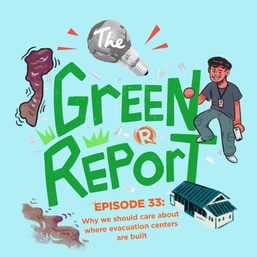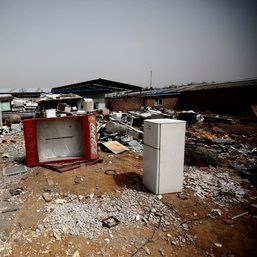SUMMARY
This is AI generated summarization, which may have errors. For context, always refer to the full article.
![[OPINION] Small is beautiful: Living energy](https://www.rappler.com/tachyon/2022/07/farmers-rappler-20130422-1.jpg)
The following is the 43rd in a series of excerpts from Kelvin Rodolfo’s ongoing book project “Tilting at the Monster of Morong: Forays Against the Bataan Nuclear Power Plant and Global Nuclear Energy.“
Our last Foray was to end by highlighting small, living energy sources, segueing into carabaos fed with ipil-ipil. But the Foray limit is 1,200 words, all needed to explore ipil-ipil properly.
So let’s now talk about animal power.
These days, most people don’t think of animals as sources of energy. But the Philippines has a long tradition of horse-drawn, two-wheeled kalesas and karetelas, and of using carabaos and oxen to plow, harrow, and draw karetons of goods and people.
Asians have long pulled rickshaws, running between their shafts like draft animals. Thankfully, inventing the bicycle elevated their labor to pedaling pedicabs; more efficient and, thankfully, uniquely human (except for circus bears). A socially acceptable occupation for the young and healthy. Not a bad job for an aspiring Tour de Filipinas athlete.
During the age of cheap petroleum, most pedicabs were replaced by motorized tricycles. In a time of greenhouse warming and ever-more expensive oil, tricycles must be either electrified, or surrender to kalesas and pedicabs, as is already happening.
No tricycles, darting dangerously like undisciplined fleas through the body of traffic, no polluting exhausts, no racket disturbing the dawn quiet. Worst of all, tricycles don’t even provide drivers with a decent living.
Most people would be healthier if they walked a kilometer or two instead of riding, anyway.
More farm kids + less farmland = smaller farms
We can’t escape the fact that the Philippine population continues to grow. True, the average Filipina had five children in the 1970s and now has only three. But this growth still keeps turning agricultural land into subdivisions, even as our coastal plains shrink, drowning under the rising seas of our warming planet, and from a much worse, less understood reason.
Not enough Filipinos realize that parts of our coastal plains are sinking much faster than the global sea-level is rising, because our wells are pumping out groundwater much faster than nature can replenish it.
The arithmetic of a growing population and shrinking agricultural land can only result in ever-smaller farms. Actually, the problem is worse, because poorer, rural residents want more children to help in the fields and to take care of them in their old age.
How big is the average Filipino farm? Estimates vary from only about 1/3rd up to 1-1/3rd hectare. Small, in any case, and bound to get smaller as divided inheritances.
How best to empower farming in a time of climate change and its impacts?
The mighty carabao, water buffalo
During my 1990s at Pinatubo volcano, two-wheeled, gasoline-powered, 15-horsepower “mechanical carabaos,” called “kuliglig” after their noise, entered the rural scene. Now doomed to extinction by the cost of oil and their mechanical flatulence, utots of greenhouse CO2, they must yield their role back to living, breathing carabaos.
A very good thing! Much less powerful, carabaos work more slowly than machines, so their users don’t have bad accidents. And a carabao can be coaxed to provide power at several times its average rate for short tasks like pulling out a truck stuck in mud.
In a time when changing climate is driving us up from coastal plains to higher slopes, and population growth is making our small farms even smaller, the carabao is the perfect power unit for farming a small tract of land, a versatile source of energy for plowing, harrowing, threshing, irrigation, and transport. Carabaos work better on steeper slopes and wetter soils than machines. In hot weather carabaos keep cool and less pestered by flies in wallows, worked only in the relative cool of dawn and twilight by wise and considerate farmers.
Carabaos are cheaper and easier to maintain than machines. Treated humanely, they don’t malfunction as frequently. Machines deteriorate and wear out, but young carabaos get obedient and more skillful over time.
Unlike machines, carabaos reproduce themselves without cost. They feed cheaply on local grass and thrive on ipil-ipil, making free fertilizer. When old and feeble, they provide meat and leather.
Leticia Ramos-Shahani, beloved giant of Philippine letters, international diplomacy, feminism, and politics, spent her last years developing carabaos as milk and cheese producers. She was a major force in 1992 to have the Department of Agriculture establish the Philippine Carabao Center, devoted to genetically improving them. Besides increasing their milk output, they need to be bred for strength, endurance, heat tolerance, and longevity.
All that said, it does take skill to drive a carabao…
A reminiscence
World War II started on December 8, 1941, 12 days before my fifth birthday. The brutal war and hiding from the Japanese occupiers until liberation in 1945 was not the nicest of childhoods.
My mom was a naturalized US citizen, and our family recuperated as war refugees with her folks in Chicago for two years – by far the best of my life until then. We could eat! For the first time, school! Classmates!
In 1947 we returned to the Philippines so Dad could build his dream, a high school in his hometown of San Antonio in Zambales province. Goodbye, classmates. I’d had serious rheumatic fever just before we moved and had to convalesce for a year. But then, even though I couldn’t even speak Ilocano yet, Dad decided I was to be a regular Zambaleño kid.
One day when I was 11 he told me to walk the few blocks to the home of our tenant farmer, borrow his carabao and cart, drive back to the house, pick up two sacks of palay – unhusked rice – drive six blocks to the rice mill, have it milled, and bring it home with its bran.
I had no experience handling carabaos. This male was young, powerful, and deeply resentful of his recent bondage. To get him between the cart shafts and yoked was a struggle.
I couldn’t control him from the cart! He was steered by a rope knotted through a hole in his nose septum, but he was a true “hardnose.” Tug the rope right or left to turn a corner, he’d go straight. Finally, I had to walk ahead of him to lead him the last two blocks home.
Two sacks of rice loaded into the kareton, I started for the mill. But a skinny mestizo kid walking the carabao and cart would look stupid, so I compromised, got the leverage to steer by riding on him, close to his head, my feet resting on the shafts.
His defiance turned to walking very slowly.
A skillful kid I’d once ridden behind had sped up his carabao by swinging the knotted end of his steering rope down to whack its testicles.
Bad idea! He felt it all right; bucked high and bolted off swiftly, still bucking wildly. I lost my balance, slid sideways and fell, my leg trapped between him and the cart shaft.
He dragged me on my back through the sandy, manure-strewn street, my head just forward of the steel-rimmed wheel, before someone ran after us, caught the rope, and stopped him.
I never did get the rice milled…
The lifelong lesson he taught me? When oppressed, never stop resisting. Never.
Next Foray? Geothermal power. – Rappler.com
Born in Manila and educated at UP Diliman and the University of Southern California, Dr. Kelvin Rodolfo taught geology and environmental science at the University of Illinois at Chicago since 1966. He specialized in Philippine natural hazards since the 1980s.
Keep posted on Rappler for the next installment of Rodolfo’s series.
Previous pieces from Tilting at the Monster of Morong:
- [OPINION] Tilting at the Monster of Morong
- [OPINION] Mount Natib and her sisters
- [OPINION] Sear, kill, obliterate: On pyroclastic flows and surges
- [OPINION] Beneath the waters of Subic Bay an old pyroclastic-flow deposit, and many faults
- [OPINION] Propaganda about faulting, earthquakes, and the Bataan Nuclear Power Plant
- [OPINION] Discovering the Lubao Fault
- [OPINION] The Lubao Fault at BNPP, and the volcanic threats there
- [OPINION] How Natib volcano and her 2 sisters came to be
- [OPINION] More BNPP threats: A Manila Trench megathrust earthquake and its tsunamis
- [OPINION] Shoddy, shoddy, shoddy: How they built the Bataan Nuclear Power Plant
- [OPINION] Where, oh where, would BNPP’s fuel come from?
- [OPINION] ‘Megatons to Megawatts’: Prices and true costs of nuclear energy
- [OPINION] Uranium enrichment for energy leads to enrichment for weapons
- [OPINION] Introducing the nuclear fuel cycle
- [OPINION] On uranium mining and milling
- [OPINION] Enriching and fabricating BNPP’s uranium fuel
- [OPINION] Decommissioning BNPP, and storing the nuclear dragon’s radioactive manure
- [OPINION] So how much greenhouse gas does nuclear power really generate?
- [OPINION] Getting up close and personal with the atom, and its nucleus that powers NPPs
- [OPINION] The nucleus and isotopes: Why BNPP needs Uranium 235, Not Uranium 238
- [OPINION] What you should know about radioactivity
- [OPINION] Uranium mine waste and the weird idea of half-life
- [OPINION] How nuclear power plants work: Hot monster piss from Morong
- [OPINION] What if there was a spent-fuel pool accident at the Bataan Nuclear Power Plant?
- [OPINION] Nuclear weaponry, its radiation, and human health
- [OPINION] What Chernobyl could have taught us, but hasn’t been allowed to
- [OPINION] Activating BNPP would give cancer to workers and adults living nearby
- [OPINION] Activate BNPP? You could increase childhood cancers in Bataan and beyond
- [OPINION] The Hanford Site: Where nuclear pollution began and still reigns
- [OPINION] Enewetak, Paradise Lost: Enewetak and its people
- [OPINION] The Cold War’s nuclear weapons tests, and the damage and waste they left behind
- [OPINION] Nuclear weapons tests and the dangers of the Runit Dome
- [OPINION] The fates of Enewetak Atoll and its people after the nuclear tests
- [OPINION] The long-term future of nuclear wastes
- [OPINION] Paying respect to our own star
- [OPINION] The paradox of the faint young sun, the origin of life, and the modern cell
- [OPINION] Sunlight and earth-glow
- How the ‘greenhouse effect’ works
- [OPINION] Global warming, climate change, and implications for the Philippines
- [OPINION] Alternative energy for a climate-challenged Philippines
- [OPINION] Small is beautiful: Ipil-ipil for a climate-challenged Philippines
Add a comment
How does this make you feel?
![[OPINION] Fossil fuel debts are illegitimate and must be canceled](https://www.rappler.com/tachyon/2024/04/IMHO-fossil-fuel-debt-cancelled-April-16-2024.jpg?resize=257%2C257&crop_strategy=attention)
![[WATCH] John Kerry: You can’t solve climate crisis without addressing ocean’s challenges](https://www.rappler.com/tachyon/2023/12/cop28-united-states-john-kerry-december-2-2023-reuters-001.jpg?resize=257%2C257&crop_strategy=attention)



There are no comments yet. Add your comment to start the conversation.